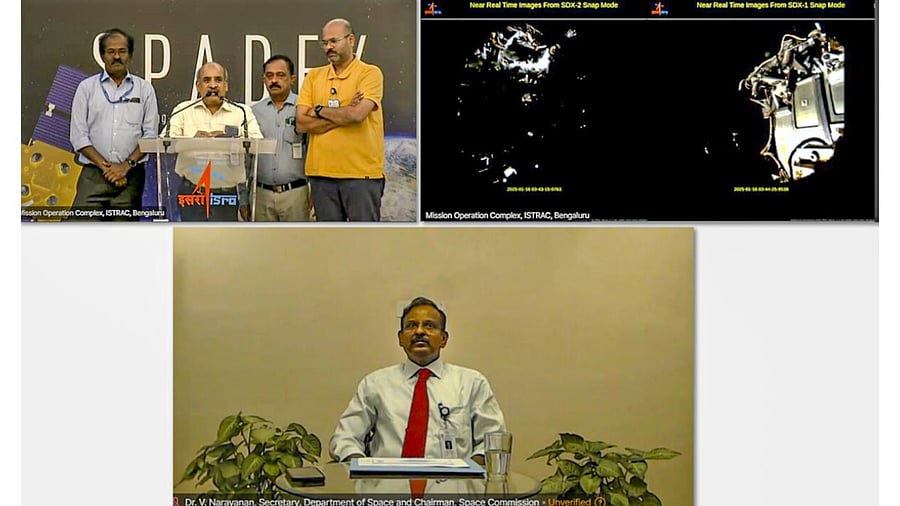
V Narayanan, Secretary DOS, Chairman Space Commission and Chairman ISRO, congratulates the team ISRO after the Indian Space Research Organisation (ISRO) successfully docked its SpaDeX satellites in space.
Credit: ISRO
Chennai: India on Thursday became the fourth country to join the elite club of nations after the Indian Space Research Organisation (ISRO) successfully docked two satellites in space. This remarkable success is crucial for India’s future missions to space like Chandrayaan-4, the country’s fourth unmanned lunar mission, the manned mission to mission Gaganyaan, sample return from the moon, and the building and operation of the planned Bharatiya Antariksh Station (BAS).
Two satellites SDX01 (Chaser) and SDX02 (Target) which were launched by the PSLV C60 on December 30, 2024 were docked with scientists at ISRO Telemetry, Tracking, and Command Network (ISTRAC) overseeing the procedure.
“Spacecraft docking successfully completed! A historic moment. Manoeuvre from 15m to 3m hold point completed. Docking initiated with precision, leading to successful spacecraft capture. Retraction was completed smoothly, followed by rigidisation for stability,” the ISRO said in a statement on Thursday morning.
After overcoming the challenges and complexities involved in mastering the art of docking satellites, India has now joined select club of US, China, and Russia.
The Space Docking Experiment satellites (SpaDeX) were docked after ISRO scientists spent several sleepless nights to successfully conduct the experiment following several hiccups.
Hours before the docking experiment on January 9, the agency found out that the drift between the two spacecraft was more than expected and postponed it once again. Since January 8 night, ISRO scientists worked overtime to correct the drift and arrested the satellites at an inter-satellite distance of 230 metres on January 11 before conducting the trial run on January 12 whose data was useful for Thursday’s successful docking.
The SpaDeX mission is aimed at developing and demonstrating crucial technology required to dock and undock spacecraft in space. It will also demonstrate several indigenous technologies, including a sophisticated docking mechanism, rendezvous and docking sensors, power transfer technology, and inter-satellite communication link (ISL) for autonomous communication between spacecraft.
Owing to its small size and mass, SpaDeX was even more challenging due to the finer precision required for the rendezvous and docking manoeuvres compared to docking two large spacecraft. “This mission will be a forerunner for autonomous docking needed for future lunar missions like Chandrayaan-4 without the support of GNSS from Earth,” the ISRO said.
The payloads included a high resolution camera mounted on SDX01 to capture the process of rendezvous, docking and undocking, while SDX02 carries a miniature multi-spectral payload (MMX) whose imaging is useful for natural resource monitoring and vegetation studies and a radiation monitor to measure radiation dose encountered in space.
With the docking successful, electrical power transfer between the two satellites will be demonstrated before their undocking and separation to start the operation of their respective payloads for the expected mission life of up to two years, scientists said, adding that in-space docking technology is essential when multiple rocket launches are required to achieve common mission objectives.